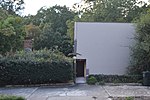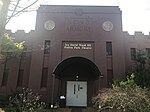Pullen Memorial Baptist Church

Pullen Memorial Baptist Church is a Baptist church known for its progressive theology located in Raleigh, North Carolina, US, right beside North Carolina State University. Pullen, called "a fiercely independent Baptist church" whose traditions have "earned it a reputation far and wide as the South's premier liberal church," has a long history of civil rights activism, and is currently a leader on key issues of the day, from LGBTQ rights to activism in Moral Monday protests to alliances with like-minded people in distant places from Cuba to Nicaragua to Georgia in the Caucasus Mountains and Black Sea. Pullen is led by the Dr. Reverend Nancy Petty. In the last two decades, social issues have included Pullen Memorial's stance on sexual issues. In 1992 the Southern Baptist Convention expelled the church for its blessing a same-sex union. In 2002, lesbian minister Nancy Petty was selected to be co-pastor with Jack McKinney, making Pullen the first Baptist church in the South known to have chosen an openly homosexual person as lead clergy. Pullen has been marrying and blessing the unions of same-sex couples ever since. Pullen's Sunday service was named "The Best Sermon to Hear on a Sunday Morning" by the Independent Weekly, a local progressive newspaper based in Durham. The church has alliances and affiliations with the Alliance of Baptists, American Baptist Churches – USA, Association of Welcoming and Affirming Baptists, Baptist Peace Fellowship of North America, Bread of the World, Church Women United, Community of the Cross of Nails, Historic Thousands on Jones Street People's Assembly, Martin Street Baptist Church, North Carolina Council of Churches, and the Triangle Interfaith Alliance.
Excerpt from the Wikipedia article Pullen Memorial Baptist Church (License: CC BY-SA 3.0, Authors, Images).Pullen Memorial Baptist Church
Hillsborough Street, Raleigh Oberlin
Geographical coordinates (GPS) Address External links Nearby Places Show on map
Geographical coordinates (GPS)
| Latitude | Longitude |
|---|---|
| N 35.785277777778 ° | E -78.660833333333 ° |
Address
Pullen Memorial Baptist Church
Hillsborough Street
27605 Raleigh, Oberlin
North Carolina, United States
Open on Google Maps










